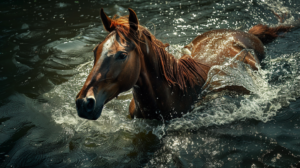Quarter Horses are among the most beloved and versatile horse breeds. Known for their remarkable speed, agility, and friendly disposition, they have become a favorite among horse enthusiasts, ranchers, and competitors alike. They are the most popular breed globally, with over 3,000,000 registered at the American Quarter Horse Association, and are widely known in the equine industry. Everyone who has an interest in horses has surely heard of this breed. But do you know how this beautiful breed came into existence and became one of the world’s most well-known and well-loved horse breeds?
Quarter Horses have always held a special place in my heart due to their remarkable versatility and gentle nature. Growing up, I had the privilege of riding and caring for a Quarter Horse named Blaze. His sturdy build and calm demeanor made him ideal for trail riding through our local woods. Beyond riding, Blaze was a companion, greeting me with a friendly nicker every time I entered the barn. This bond with a Quarter Horse taught me the enduring qualities that define these incredible animals: their adaptability, loyalty, and unwavering spirit in every adventure we shared together.
In the early 19th century, other breeds, such as Thoroughbreds, outshone quarter horses due to their superior endurance. However, quarter horses gained prominence among cowboys and ranchers for their innate cow sense and friendly temperament. Join us to delve into the history, exceptional traits, attractive colors, and interesting facts about quarter horses.
Origin of Quarter Horses
American quarter horses descended from native horses of Spanish origin, and English horses used in American colonies were imported to Virginia in the 1600s. They were also crossed with other local breeds, such as the Chickasaw horse, and are known for having Thoroughbred blood. Other influential sires who helped build this breed include Steel Dust (b. 1843), Peter McCue (b. 1895), and Janus, who were brought to Virginia in 1756.
It was bred for performance, and because of its excellent performance in quarter-mile races, agility, and natural cow sense, it became a top favorite among settlers. Due to its inherent speed, it became useful for cowboys, farmers, and those who needed reliable transportation over rough terrains. Although the breed initially existed in the 1600s, the American Quarter Horse Association was only established in 1950. However, it has become the largest horse breeder’s organization globally, with 2.5 million registered horses in its studbook and registry by the late 20th century. The horse’s lifespan depends on factors such as care, genetics, and health maintenance.
Fun fact: Did you know how the quarter horse got its name?
Quarter horses can outrun other horse breeds in quarter-mile races, hence the quarter horse.
BREED PROFILE:
Average Weight: 950 to 1,200 pounds (431 to 544 kg)
Average Height: 14 hands (56 inches) to 16 hands (64 inches)
Body type: Muscular body, compact appearance, deep chest, small head with a broad forehead and flat profile
Used for Farmwork, leisure, and horse shows
Average Life Expectancy: 25 years
Is the quarter horse a Warmblood?
American quarter horses are descendants of hot-blood breeds, Appaloosas, and Paint horses. Still, it is also considered by many as an original American Warmblood since it has Thoroughbred roots.
Can a quarter horse beat a thoroughbred?
Both horse breeds are great racers, but Quarter horses are usually faster than Thoroughbreds on short distances since they can accelerate and reach their top speed easily. However, Thoroughbreds can easily ace longer distances. As we all probably know, performance varies in every horse, and extensive training plays a big role in how a horse’s strengths develop.
Quarter Horse Colours
Quarter horses are available in 17 colors: sorrel, bay, black, brown, chestnut, red, dun, cremello, red, blue bay roan, Palomino, buckskin, and more. Let’s explore some of them by closely examining these visually enthralling equines.
- Palomino Quarter Horses
Did you know that 50% of Palomino horses are Quarter Horses? Many breeds can produce a palomino, but out of the long list, the best odds seem to come with quarter horses. For a quarter horse to be considered Palomino, it must have a single allele of a dilution gene known as a cream gene that works on a red or chestnut base coat. This genetic color has a hint of gold in its coat and white or light cream in its mane and tail. The degree of whiteness can vary from bright white to yellow. Nevertheless, it’s an elegant color that makes the quarter horse more visually appealing and highly desired.
- Buckskin Quarter Horses
This quarter horse possesses a beautiful color that resembles a particular shade of tanned deerskin. It has a single cream dilution gene that creates the tan or gold-colored coat, and it also has some specific black points along its mane, tail, and lower legs.
- Black Quarter Horses
Black is also a common color among quarter horses and is no less beautiful than other colors. The pure black coat with no lighter areas shines when the light strikes it, making it even more gorgeous and elegant. However, due to sun exposure, it might fade in time.
What is the rarest color of a quarter horse?
The rarest quarter horse colors are champagne, silver, and appaloosa. Champagnes exhibit metallic, shiny coats, while silver ones have the black and dilution gene. Only a few appaloosas were registered in AQHA, and one of those who made it onto the list is the stallion Reminic In Spots.
Advantages of Quarter Horses
1. They have a good temperament
Quarter horses are well-known for having calm temperament. Their calmness and friendliness make them ideal for kids and those new to spending time with horses. Choosing equines that can control themselves is essential, even if your child does something wrong. These horses love being cuddled, and it’s easy to form a strong bond with a Quarter horse due to its calm nature.
2. It’s easy to ride on
They have a wider back and shoulders than many other breeds, so it is easier to get a good grip as it runs faster. You can also sit comfortably and tightly, turn around, and stop because they have a short back. It is among the breeds that are steady and willing to learn from the rider.
3. It’s Very Fast
Quarter horses have healthy joints and muscles, so they can sprint over long distances and quickly accelerate while keeping a good ground speed for a long stretch. Some quarter horses can run as fast as 55mph (86 km/h) faster than other horses by any standard.
4. It has an excellent “Cow sense.”
They also have an innate talent for working effectively with cattle. Reports say that they have a special feeling about what cows will do, and they can predict their movement before their rider can react. They’re not easy to provoke, making cattle management much easier. That’s why it’s a ranch and farm favorite. Many farmers also prefer them over ATVs and other vehicles as engines tend to frighten and stress cattle, making Quarter horses a better alternative.
5. They excel in rodeo games, horse shows and races
Since quarter horses are generally easier to maneuver, handle, and hold onto than other horse breeds, they dominate most rodeo sports. They also ace most horse shows, thanks to their muscular and compact appearance, beautiful skin colors and style, and ability to collaborate with the rider effectively. They can also run at an incredible speed, making them one of the fastest horses on the planet.
Exciting Facts About Quarter Horses
You’ll love quarter horses for their outstanding qualities, but here are some amazing facts about them that will give you more insight into their rich, colorful history.
1. One of the most successful racehorses of all time was an American Quarter Horse, and he’s a Hall of Famer!
Easy Jet, an American Quarter horse born in 1967, had a very successful career, winning 27 out of 38 events he competed in. He is also one of only two horses who became a member of AQHA’s “Hall of Fame.” Three of his offspring also became winners of the All-American Futurity race. By the time Easyjet died in 1993, his foal’s career earnings had reached $25 million while his breeding rights shares capped at $30 million.
2. More American Quarter Horses live in Texas than anywhere else in the world.
AQHA is based in Texas, USA, with more than 420,000 American Quarter Horses in Texas alone. On average, every owner has 4 American Quarter Horses in their stable.
3. There are three distinct categories for American Quarter Horses.
Breeders classify this horse breed into Bulldog, Thoroughbred, and Progressive. Bulldog Quarter horses have strong legs and stamina, and it’s commonly the working horse of the breed. On the other hand, Thoroughbreds are sleeker, and they have finer bones. Some may be called semi-bulldogs or runners, while Progressive horses combine the two categories.
4. The studbook for the American Quarter Horse is open to Thoroughbred horses.
A thoroughbred horse may qualify for registration with the AQHA if it meets the performance standard. That’s why there are two classifications for Quarter Horses: the foundation and appendix classification, where the horse can enter competitions, but its offspring will not receive full initial AQHA registration.
But there’s a twist: American Quarter Horses can transfer from the appendix section to the foundation section of the studbook if they can meet the conformational criteria and have shown up or competed successfully at sanctioned association events. In this case, its offspring will immediately become eligible for AQHA registration.
5. The total purse for AQHA-approved shows is more than $129 million annually.
Every year, AQHA approves 15,000 starters in their registration for 7,900 sanctioned events held in the US. There are also over 2,000 approved shows each year, which receive around 380 entries.
Where to Find Quarter Horses
As mentioned above, about 420,000 registered American Quarter horses in the AQHA (the world’s largest equine breed registry) came from Texas, and around 53,000 quarter horses live in Ohio. You also find this beautiful breed from ranches and breeders around the world.





